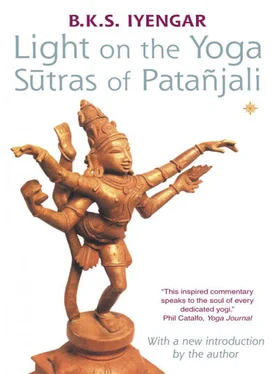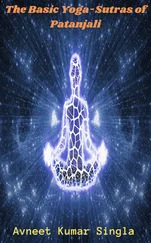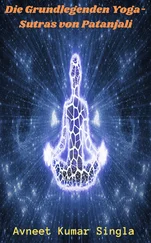In the second chapter, sadhana pada , Patañjali comes down to the level of the spiritually unevolved to help them, too, to aspire to absolute freedom. Here he coins the word kriyayoga. Kriya means action, and kriyayoga emphasizes the dynamic effort to be made by the sadhaka. It is composed of eight yogic disciplines, yama and niyama, Asana and pranayama, pratyahara and dharana, dhyana and samadhi. These are compressed into three tiers. The tier formed by the first two pairs, yama and niyama, Asana and pranayama, comes under tapas (religious spirit in practice). The second tier, pratyahara and dharana, is self-study ( svadhyaya). The third, dhyana and samadhi , is Isvara pranidhana, the surrender of the individual self to the Universal Spirit, or God (Isvara).
In this way, Patañjali covers the three great paths of Indian philosophy in the Yoga Sutras. Karmamarga , the path of action is contained in tapas; jñanamarga , the path of knowledge, in svadhyaya; and bhaktimarga , the path of surrender to God, in Isvara pranidhana.
In this chapter, Patañjali identifies avidya , spiritual ignorance, as the source of all sorrow and unhappiness. Avidya is the first of the five klesas, or afflictions, and is the root of all the others: egoism, attachment, aversion and clinging to life. From these arise desires, sowing the seeds of sorrow.
Afflictions are of three types. They may be self-inflicted, hereditary, or caused through imbalance of elements in the body. All are consequences of one’s actions, in this or previous lifetimes, and are to be overcome through practice and renunciation in the eight yogic disciplines which cover purification of the body, senses and mind, an intense discipline whereby the seeds are incinerated, impurities vanish, and the seeker reaches a state of serenity in which he merges with the seer.
For one who lacks ethical discipline and perfect physical health, there can be no spiritual illumination. Body, mind and spirit are inseparable: if the body is asleep, the soul is asleep.
The seeker is taught to perform Asanas so that he becomes familiar with his body, senses and intelligence. He develops alertness, sensitivity, and the power of concentration. pranayama gives control over the subtle qualities of the elements – sound, touch, shape, taste and smell. Pratyahara is the withdrawal into the mind of the organs of action and senses of perception.
Sadhana pada ends here, but Patañjali extends dharana, dhyana and samadhi , the subtle aspects of sadhana , into the next chapter, vibhuti pada. These three withdraw the mind into the consciousness, and the consciousness into the soul.
The journey from yama to pratyahara , described in sadhana pada , ends in the sea of tranquillity, which has no ripples. If citta is the sea, its movements (vrttis) are the ripples. Body, mind and consciousness are in communion with the soul; they are now free from attachments and aversions, memories of place and time. The impurities of body and mind are cleansed, the dawning light of wisdom vanquishes ignorance, innocence replaces arrogance and pride, and the seeker becomes the seer.
The third chapter speaks of the divine effects of yoga sadhana. It is said that the sadhaka who in this state has full knowledge of past, present and future, as well as of the solar system. He understands the minds of others. He acquires the eight supernatural powers or siddhis: the ability to become small and large, light and heavy, to acquire, to attain every wish, to gain supremacy and sovereignty over things.
These achievements are dangerous. The sadhaka is cautioned to ignore their temptations and pursue the spiritual path.
Sage Vyasa’s commentary on the sutras gives examples of those who became ensnared by these powers and those who remained free. Nahusa, who belonged to the mortal world, became the Lord of heaven, but misused his power, fell from grace and was sent back to earth in the form of a snake. Urvasi, a famous mythical nymph, the daughter of Nara Narayana (the son of Dharma and grandson of Brahma), became a creeping plant. Ahalya, who succumbed to sensual temptation, was cursed by Gautama and became a stone. On the other hand, Nandi, the bull, reached Lord siva. Matsya, the fish, became Matsyendranath, the greatest hatha yogi on earth.
If the sadhaka succumbs to the lure of the siddhis , he will be like a person running away from a gale only to be caught in a whirlwind. If he resists, and perseveres on the spiritual path, he will experience kaivalya , the indivisible, unqualified, undifferentiated state of existence.
In the fourth chapter, Patañjali distinguishes kaivalya from samadhi. In samadhi , the sadhaka experiences a passive state of oneness between seer and seen, observer and observed, subject and object. In kaivalya , he lives in a positive state of life, above the tamasic, rajasic and sattvic influences of the three gunas of nature. He moves in the world and does day-to-day work dispassionately, without becoming involved in it.
Patañjali says it is possible to experience kaivalya by birth, through use of drugs, by repetition of mantra , or by tapas (intense, disciplined effort) and through samadhi. Of these, only the last two develop mature intelligence and lead to stable growth.
Man may make or mar his progress through good actions or bad. Yogic practices lead to a spiritual life; non-yogic actions bind one to the world. The ego, ahamkara, is the root cause of good and bad actions. Yoga removes the weed of pride from the mind and helps the seeker to trace the source of all actions, the consciousness, wherein all past impressions (samskaras) are stored. When this ultimate source is traced through yogic practices, the sadhaka is at once freed from the reactions of his actions. Desires leave him. Desire, action and reaction are spokes in the wheel of thought, but when consciousness has become steady and pure, they are eliminated. Movements of mind come to an end. He becomes a perfect yogi with skilful actions. As wick, oil and flame combine to give light, so thought, speech and action unite, and the yogi’s knowledge becomes total. For others, whose knowledge and understanding are limited, an object may be one thing, experience of the object another, and the word quite different from both. These vacillations of mind cripple one’s capacity for thought and action.
The yogi differentiates between the wavering uncertainties of thought processes and the understanding of the Self, which is changeless. He does his work in the world as a witness, uninvolved and uninfluenced. His mind reflects its own form, undistorted, like a crystal. At this point, all speculation and deliberation come to an end and liberation is experienced. The yogi lives in the experience of wisdom, untinged by the emotions of desire, anger, greed, infatuation, pride, and malice. This seasoned wisdom is truth-bearing (rtambhara prajña). It leads the sadhaka towards virtuous awareness, dharma megha samadhi , which brings him a cascade of knowledge and wisdom. He is immersed in kaivalya , the constant burning light of the soul, illuminating the divinity not only in himself, but also in those who come in contact with him.
I end this prologue with a quotation from the Visnu Purana given by sri Vyasa in his commentary on the Yoga Sutras : ‘Yoga is the teacher of yoga; yoga is to be understood through yoga. So live in yoga to realize yoga; comprehend yoga through yoga; he who is free from distractions enjoys yoga through yoga.’
Читать дальше












